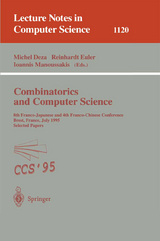Advances in Structural and Syntactical Pattern Recognition
Springer Berlin (Verlag)
978-3-540-61577-4 (ISBN)
The 36 revised full papers included together with three invited papers were carefully selected from a total of 52 submissions. The papers are organized in topical sections on grammars and languages; morphology and mathematical approaches to pattern recognition; semantic nets, relational models and graph-based methods; 2D and 3D shape recognition; document image analysis and recognition; and handwritten and printed character recognition.
Efficient recognition of a class of context-sensitive languages described by Augmented Regular Expressions.- Optimal and information theoretic syntactic pattern recognition for traditional errors.- The morphic generator grammatical inference methodology and multilayer perceptrons: A hybrid approach to acoustic modeling.- Two different approaches for cost-efficient Viterbi parsing with error correction.- Bounded parallelism in array grammars used for character recognition.- Comparison between the Inside-Outside algorithm and the Viterbi algorithm for stochastic context-free grammars.- Generalized morphological operators applied to map-analysis.- Derivatives in scale space.- On skeletonization in 4D images.- Extended Cascade-Correlation for syntactic and structural pattern recognition.- A metric of planar self-similar forms.- Including geometry in graph representations: A quadratic-time graph isomorphism algorithm and its applications.- Hierarchical discrete relaxation.- Relational indexing.- An evidential merit function to guide search in a semantic network based image analysis system.- Inexact graph matching with genetic search.- Automatic recognition of bidimensional models learned by grammatical inference in outdoor scenes.- Signal decomposition with multiscale learning algorithms.- Structural learning of character patterns for on-line recognition of handwritten Japanese characters.- Recognition of hand-printed characters using induct machine learning.- Opponent color processing based on neural models.- Knowledge acquisition by symbolic decision tree induction for interpretation of digital images in radiology.- Invariants and fixed structures lead the way to change.- Representing shape by line patterns.- Recognition of 3D objects from 2D images - Some issues.- Surface skeletonization of volume objects.- Peculiarities of structural analysis of image contours under various orders of scanning.- A structural analysis of curve deformation by discontinuous transformations.- Three dimensional computer vision for computer aided design and manufacturing applications.- Using weighted minutiae for fingerprint identification.- Recognizing 2-D rigid and non-rigid wire-shapes.- Structural and syntactic methods in line drawing analysis: To which extent do they work?.- Vector-based segmentation of text connected to graphics in engineering drawings.- Automatic resolution of object features from engineering drawings for 3D reconstruction.- The feedback approach to cartographic areal text placement.- A hierarchical representation for the reference database of on-line Chinese character recognition.- Substructure shape analysis for Kanji character recognition.- Recognition of hand-printed Chinese characters using Ripple Down Rules.- A fuzzy syntactic method for on-line handwriting recognition.
| Erscheint lt. Verlag | 7.8.1996 |
|---|---|
| Reihe/Serie | Lecture Notes in Computer Science |
| Zusatzinfo | X, 426 p. |
| Verlagsort | Berlin |
| Sprache | englisch |
| Maße | 155 x 235 mm |
| Gewicht | 618 g |
| Themenwelt | Informatik ► Grafik / Design ► Digitale Bildverarbeitung |
| Informatik ► Theorie / Studium ► Künstliche Intelligenz / Robotik | |
| Schlagworte | 3D • algorithms • Bildanalyse • Bildverarbeitung • Character Recognition • Cognition • computer vision • Document Analysis • Dokumentenanalyse • Formerkennung • Hardcover, Softcover / Informatik, EDV/Informatik • HC/Informatik, EDV/Informatik • Image Analysis • learning • machine learning • Mustererkennung • pattern recognition • shape recognition • Zeichenerkennung |
| ISBN-10 | 3-540-61577-6 / 3540615776 |
| ISBN-13 | 978-3-540-61577-4 / 9783540615774 |
| Zustand | Neuware |
| Haben Sie eine Frage zum Produkt? |
aus dem Bereich




